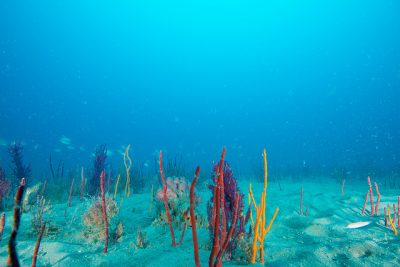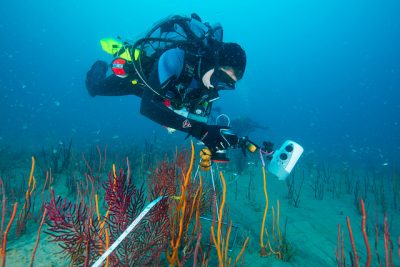This story has been corrected from its original form, which incorrectly attributed the National Science Foundation’s seismic testing to the U.S. Geological Survey.
MOREHEAD CITY — Almost anyone who’s thrown a hook in the water to catch a fish in a quiet atmosphere probably knows intuitively that loud noises spook them: you don’t scream at fish to bite, after all, you wait patiently.
Supporter Spotlight
But intuition isn’t science, and seismic airguns don’t make just any loud noise, so when University of North Carolina Institute of Marine Sciences doctoral student Avery Paxton and some colleagues got the opportunity to do some real science on an issue that’s germane to the hot topic of oil and gas exploration by seismic surveys, they jumped at the chance.
What they found, back in September 2014 when they did a study during a National Science Foundation seismic mapping effort in the Atlantic Ocean off Beaufort Inlet, not only confirmed intuition, but surprised them in its degree: 78 percent of the fish on a reef near the seismic survey “went missing,” compared to counts at the same time the three previous days during the evening hours, the peak time for fish, such as snapper, grouper and angelfish, to gather there.

“There had been hundreds of fish in the evenings before the survey took place,” Paxton said. “The numbers had been low to moderate in the morning and afternoon, but what we found was that after the survey, it (fish numbers) did not peak like it usually does in the evening.”
They got the numbers by painstakingly counting the fish on the videos, even by species. They had collected 10-second-long videos every 20 minutes for three days, before and through the day when the seismic surveying occurred.
“Noises from seismic surveying were audible as discrete airgun shots in video recordings, allowing us to associate any observed behavioral responses with timing of individual shots. To prevent observer bias, fish were first counted with video sound turned off; then sound was turned back on to detect whether shots were present,” the paper states.
Supporter Spotlight
It was, Paxton said, as if only one of five members of a human family came home in the evening after school and work. You’re not sure where they went, or how long they stayed away from the house, but they sure weren’t where they usually were.
The peer-reviewed study was recently published online in “Marine Policy,” a science journal that focuses on ocean policy studies, and is due to be published in the paper version of the journal in April.
While researchers have long known much about the effects of seismic activity on whales and dolphins and other marine mammals, this was, according to Paxton, a student in Pete Peterson’s lab at UNC-IMS, the first study to document how multiple species of fish respond to seismic surveys in their natural environment.
Paxton noted that more research is needed before conclusions should be drawn about how long the fish stayed away, or where they went. The researchers surmise they went to a nearby, quieter reef, but the study shows that, “we need to consider fish when we think about seismic surveys. We can’t ignore it.”
The research was funded by the Bureau of Ocean Energy Management, the federal agency that permits seismic surveys for oil and gas deposits, as well as drilling. Colleagues involved in the project included Peterson of UNC-IMS, Chris Taylor of the National Oceanic and Atmospheric Administration’s National Ocean Service, Julian Dale of the Duke University Marine Laboratory, Elijah Cole of the Duke University Pratt School of Engineering, Christine Voss of UNC-IMS and Doug Nowacek of the Duke lab. Nowacek is one world’s leading experts on marine mammals, and has been outspoken in expressing concern about the potential effects of seismic surveys on the feeding, mating and migration of whales, including the endangered right whale.
Paxton and the others conducted their study at a natural rock reef and popular fishing spot – the “210 rock” – about 30 miles offshore from Beaufort Inlet, at a depth of 100 feet.

They had learned, shortly beforehand, that the National Science Foundation’s mapping effort was going to be in the area, and managed to get microphones and video cameras posted to monitor the reef and the fish populations. The academic objective of the seismic survey was to study the formation and evolution of the Eastern North American Margin, and involved use of an airgun array of similar volume to those used during oil and gas exploration. Most of the survey occurred in deep waters off the continental shelf, although it continued across the continental shelf and into shallow shelf waters of northeastern Onslow Bay. The area, according to the paper, supports hard-bottom reefs that sustain an abundance of fish, including tropical, subtropical, and warm-temperate species.
“It was a rare opportunity, and we’re grateful to get the opportunity and grateful that BOEM provided funds,” Paxton said. During the whole marine mammal-driven seismic survey debate – President Obama finally banned it off the Atlantic Coast right before he left office in mid-January – “I had wondered what was happening to the fish,” she added.
It’s a particularly important question at reefs, because they are crucial to some species of fish, many of which are valuable to commercial and recreational fisheries. The fish eat there, reproduce there and seek shelter from potential predators
A one-time event like the mapping survey likely just moved the fish away temporarily, Paxton noted, but she wonders for how long, and she, like other marine scientists, such as Nowacek, is concerned about the cumulative effects on things that live in the water when oil and gas surveys take place for days, almost continuously, sometimes by multiple vessels.
At one point, eight seismic survey firms had applied for permits to search for oil and gas off North Carolina. They fire their multiple airguns as often as every 10 to 12 seconds, sometimes more than 7,000 blasts in 24 hours. Experts say the sounds can carry for hundreds or thousands of miles.
Research shows that the blasts’ intensity exceeded 170 decibels, so loud it overloaded the microphones.
Often seismic sound levels are compared to jet engine noise, but Paxton said the comparison isn’t fair, because sound is different in water than in air. She said an exploding grenade may be a more accurate comparison. A jet engine at 75-80 feet away can be about 140 decibels. Sounds louder than 85 decibels can cause permeant hearing loss in humans. The Natural Resources Defense Council says, “a substantial and growing body of research now indicates that ocean noise pollution negatively affects at least 55 marine species, including several endangered species of whales and 20 commercially valuable species of fish.”
Reefs are normally quiet, with just the sounds of shrimp “crackling” and other marine species eating.
Seismic Industry Disputes Study

Gail Adams-Jackson, vice president for communications for the International Association of Geophysical Contractors, called the study incomplete and limited, noting it was one day at one site.
“Second, the effect is no different from what has been reported elsewhere where fisheries and seismic have coexisted for decades: the Gulf of Mexico, the North Sea, West Africa and throughout the world,” she said. “Marine seismic surveys have been conducted since the 1950s and experience shows that fisheries and seismic activities can and do coexist. There has been no observation of direct physical injury or death to free-ranging fish caused by seismic survey activity, and there is no conclusive evidence showing long-term or permanent displacement of fish.”
Further, she said, the seismic industry works with local fishing organizations to coordinate activities.
Still, Adams-Jackson said, the seismic industry “takes these concerns seriously, even if the substance behind them is of variable quality. While no harmful effects on ecosystems or fisheries have been found from seismic surveys, we continue to encourage and support additional study and monitoring.”
The seismic industry, along with oil and gas companies, are supporting more than $1 million worth of research on the topic.
Regulators Support Research
Connie Gillette, a spokesperson for BOEM, said the agency funded the study because “BOEM is very interested in research on sound as it relates to fish and marine mammals. Since 1998, BOEM has invested more than $50 million on protected species and sound-related research, including fish and marine mammals,” she added.
BOEM is a leading contributor to the growing body of scientific knowledge about the nation’s marine and coastal environment. The bureau regularly relies on the expertise of universities and other science organizations.
“This study is a snapshot in time but didn’t follow up on what was happening on the reef after the surveys were taken. We’re funding an additional study with NOAA to learn more about the effects of sound on fish and fish populations.”
Gillette said there had been few studies conducted in the open ocean focused on how fish respond to human-produced sound.
“BOEM has funded laboratory-based experiments to address the consequences of sound exposure to fish, but these experiments have limitations as to how they represent what happens in the real world,” Gillette said. “As with any scientific investigation, these field-based observations add to our understanding of how fish may respond to sound, but like many scientific efforts, more questions are often raised than answered. We’re funding an additional study with NOAA to learn more about the effects of sound on fish and fish populations.”
That study is looking closely at black sea bass, which according to BOEM, “show affinity” for certain habitats within oil- and gas-lease areas. In addition, black sea bass produce sounds, such as grunts and thumps, which have been associated with feeding and escape.
“Commercial and recreational fishermen have expressed concern that noise produced during sub-bottom surveys, pile-driving, and operation of renewable energy facilities may have a negative effect on the behavior of black sea bass ranging from catchability to long-term sub-lethal behavioral impacts. This species is known to utilize mid-frequency acoustics to communicate during spawning and feeding but their sensitivities to anthropogenic sounds, and their behavioral responses to them is not understood.”
The study summary also notes that black sea bass could be vulnerable to sounds generated by offshore wind development, because the fish are known to use acoustic communication and because their habitats overlap within renewable energy lease areas.
Expectations Validated

Paxton acknowledged the validity of some of the criticism, and she expected it. She and her colleagues would love to participate in follow-up studies, but Paxton stands by the conclusion that the results generated by their work show in clear terms that concerns about effects of seismic surveys on fish are warranted.
“Although working with limited data, this study provides evidence that during exposure to seismic noise, the prevailing pattern of heavy fish use of reefs during the evening was suppressed,” according to the report. The finding is notable because it goes well beyond detection of a startle response from individual fish, instead suggesting a multi-species response to airgun noise.
The Magnuson-Stevens Fishery Conservation and Management Act of 2007, the nation’s main fisheries-protection law, “mandates protection of reefs, including those studied here, as Essential Fish Habitat,” the paper adds. “Reducing opportunities for fish to aggregate causes concern as this could reduce options for foraging, mating, or other important life history functions. Though there are no observations to indicate the duration of the observed effect, these research results augment and confirm issues raised by marine mammal experts and suggest that concerns associated with marine seismic surveys appear to be realistic and well-founded.”







